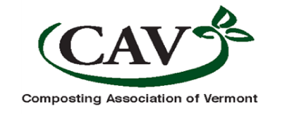What Is Compost?
Compost is a soil-like product made from decomposed organic materials commonly referred to as ‘feedstocks.’ Compost feedstocks can include yard debris, wood materials, food scraps and food processing byproducts, manure and agricultural residues, land clearing debris, and used paper. Composting is a process of aerobic decomposition that requires the presence of oxygen, moisture, and a proper balance of nutrients to create optimum conditions for decomposer organisms to break down the raw materials.
Why Use Compost?
Compost is a soil conditioner that also provides some fertility to plants. Using compost, whether home made or store bought, recycles nutrients and organic materials that help grow trouble-free plants with less water, fertilizer or pesticides than without compost. In general, using compost can result in:
Increased soil fertility: better root and plant growth
Increased organic matter and improved soil structure: increased resistance to erosion, runoff, and compaction
Increased disease resistance in plants: healthier plants are less vulnerable to pests and disease, in turn reducing pesticide use
Increased soil biological diversity and activity
When you use compost, you help the environment and the local economy by:
Reducing the use of herbicides and fertilizers
Supporting markets for local compost producers: keeping money in the community and relying less on long-distance trucking
Avoiding landfill disposal costs for “green” material
Conserving water – saving on water bills and time spent watering.
Adding compost to soil, and as a top dressing on turf provides many benefits for plant health and water storage. For the homeowner, a good, finished compost should have the following qualities:
Be black or dark brown in color with a uniform appearance
Have an earthy smell
Be at air temperature
Have a crumbly, not chunky, texture
Be in aggregates of one-inch particles or less, unless for use as mulch or erosion control
Factors affecting compost quality and nutrient content:
Feedstocks
Length of composting process and “curing”
Pile management practices – recipes, pile monitoring, and pile aeration
Product testing
Compost management and monitoring
As mentioned above, compost quality is in part determined by the feedstocks used. Not all feedstocks have the same nutrients. Also critical to compost quality are the composting methods used, particularly as they affect the maturity of the finished product. Maturity refers to the level of stability which the nutrients and other chemical compounds have reached.
Proper management of a compost pile or windrow requires monitoring of pile temperature, moisture, and condition. Healthy pile conditions are those that promote vigorous microbial activity. In turn, the microbes process the raw materials into a more stable, humus-like product. At the same time these microbes also create large amounts of heat, which drive pile temperatures as high as 130-160 degrees Fahrenheit (F). These temperatures and the diverse decomposer communities destroy weed seeds and pathogens.
There are a number of composting methods employed to produce compost on a commercial or farm scale. These can be broken into three general categories: aerated windrow composting, passive windrow composting, and vermicomposting (composting with worms). The method and care with which compost is produced affects the quality of the finished product.
Compost stability or maturity is ensured by good monitoring and management during composting, including product testing. In general, the primary management practice employed to produce compost is aeration, which is commonly done by turning piles or otherwise agitating them. The degree and frequency of aeration is a management response to pile monitoring and conditions such as oxygen and moisture availability in the pile and the pile’s resulting microbial activity. Without the right balance of air and moisture in the pile during the composting process, the microbial activity may slow, phytotoxins (or plant toxins) may develop, nitrogen may be lost from the pile, and the benefits of a high quality, mature compost may not fully develop.
The stability of the product is also increased by allowing the compost to “cure” for at least four weeks following active composting. Composters commonly use temperature probes to monitor pile temperatures (the body heat of the active microbial populations). By sampling compost from the pile with their hands, they use their sense of touch to determine pile moisture conditions. They also use their eyesight to judge pile and site moisture, as well as pile structure and texture, and they use their sense of smell to assess the gaseous loss of nutrients or the excessive presence of volatile organic acids. Whether or not a compost is considered good is also determined by its appropriateness for a desired use. For example, you would not want a compost with lots of visible woodchip in it for incorporating into your garden. However, such a product (assuming it is otherwise a finished product) can provide a good cover material in landscape applications and can also be used for erosion control in residential, commercial and resource conservation applications. Compost can also be blended with organic fertilizers and other soil amendments to meet specific horticultural needs.
What are the economic benefits?
By using compost as a soil amendment or mulch, you can cut costs and:
Reduce the use of herbicides
Reduce the use of chemical fertilizers
Support markets for local compost producers
Avoid landfill disposal costs for “green” material
Conserve water – saving on water bills, less time watering
What are the environmental benefits?
Composting yard waste and kitchen scraps is one of the best and easiest things you can do to reduce what goes to the landfill, to grow healthy, sustainable gardens and lawns, and to discourage chemical runoff into our waterways. Using compost – whether home made or store-bought – recycles nutrients and organic matter that helps grow trouble-free plants with less water, fertilizer or pesticides. In addition, by diverting organic materials from landfills you reduce their environmental impact, including green house gas emissions. In general, the benefits from using compost as a soil amendment or mulch are:
Increased soil fertility
Improved soil structure: increased resistance to erosion and runoff
Increased water holding capacity (i.e. water conservation)
Improved disease resistance in plants: less pesticide use



